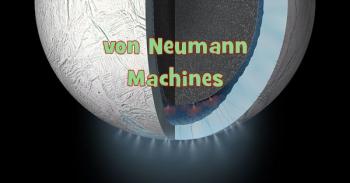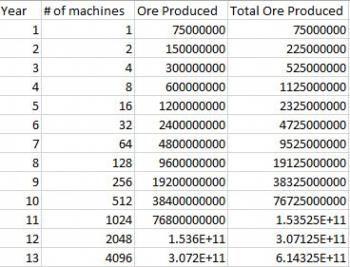Ask Professor Puzzler
Do you have a question you would like to ask Professor Puzzler? Click here to ask your question!
Richard from Los Angeles asks, "What is a von Neumann Machine?"

Hi Richard, a von Neumann machine is a concept for a machine that is self-replicating. This means that it is a machine capable of building another machine just like itself. This idea has been around for quite awhile (there's even an anecdote about Rene Descartes telling Queen Christina of Sweden that the human body is just a machine, and she responded by pointing at a clock and challenging him to make it produce offspring). And that's actually, in a sense, the concept of a von Neumann machine - it's a machine that produces offspring.
So let's take a look at a couple examples of how a von Neumann machine might be used, if we could build one.
Mining Ore
Let's say you built a machine that could mine iron from an asteroid. We'll suppose that it can mine 200,000,000 kg of iron ore per year. If this was a large asteroid (let's say, 1020 kg), it would take 500 million millenia to mine the entire asteroid.
You could build more machines to help speed the process up, but if you built 1000 machines, it would still take 500 thousand millenia to mine it.
So a clever approach would be to build a machine that mines ore, and then uses part of the ore to build another machine just like it. There are trade-offs to this approach, and we'll make some assumptions to help explore those trade-offs.
First, we'll assume that the machine can only mine ore for half the year, because it's spending the other half building a machine. This means that it can only mine 100,000,000 kg per year instead of 200,000,000 kg.
Second, we'll assume that the machine has to use a quarter of the ore mined to build its "offspring". This means that there's only 75,000,000 kg of ore produced that is actually "produced" each year per machine.
So at the end of the first year, we now have two machines instead of just one. This means that the second year, we can produce 150,000,000 kg or ore. The next year we'll have 4 machines, then 8, etc. After 11 years we'll have just over 1000 machines, and it'll only take 22 years to have over a million mining machines on the asteroid.
Here's a table that shows the first few years. The first column is the year number. The second is the number of machines. The third is the ore produced that year, and the final column is the total ore produced for the entire length of the project (the sum of all the ore production).

Terraforming Mars
Freeman Dyson (known for the Dyson Sphere) proposed that if we want to terraform Mars (make it like earth, so humans can live on it), we're going to need to import massive amounts of water. Where will we get it? Saturn has a moon (Enceladus) which has a very thick crust of pure, clean ice.
So Dyson proposed that we could, theoretically, build a machine which is capable of doing all of the following tasks:
- mine ice from the surface
- mine iron ore from the core
- use the iron ore to replicate itself
- use the iron ore to also build a simple unmanned spacecraft capable of navigating to Mars
- load the ice into the craft
Obviously, this machine is going to be very sophisticated. If you think about it, a self-replicating machine is actually an entire factory. And this one is a factory that produces both a mining machine and a flying machine. But if we could do it, the amount of ice we could move to Mars would grow exponentially with each year.
Space Exploration
Why not use this concept for space exploration? Build a space probe that's capable of landing on an asteroid and using the raw materials of that asteroid to create one, or even a thousand copies of itself before heading for the next solar system. Each of those copies heads out in a different direction and repeats the process, and all the while reporting back to planet earth what they see along the way. Considering the massive amount of time it'll take to travel from one solar system to the next, mapping and exploring the galaxy is an absurdly monstrous task, so this is definitely a situation where having the number of probes increasing exponentially would be of great value.
Other Ideas?
What do you think? What are some other ways we could use von Neumann machines?


